From early modern maps, we are whisked away to South America. To most of Graham Hancock’s readers, this will be exotic stuff. At school, we learn about Sumeria, Egypt, Mesopotamia, Greece and Rome, but it is a rare teacher who will spend time on the lesser known civilisations of South America (which, to readers of literature like Fingerprints of the Gods, includes Mexico, which is actually in North America). True, most of his readers will be aware of the Maya (North American, incidentally) and the Inka, but Hancock is about to unleash all manner of unfamiliar names. Little wonder, then, that the material he discusses in Part II may seem impressive and good evidence for a “Lost Civilisation”.
Chapter 4: the Nazca lines
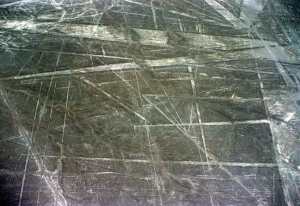
As with his discussion of early modern maps, Graham Hancock begins with something that is depressingly familiar to readers of “alternative history”, the lines and symbols that are scattered across the Plain of Nazca, in the Ica region of Perú. The Plain lies some 360 km south-south-east from Lima and is accessible only by road. The lines were rediscovered in 1926 (although Wikipedia says 1927) by Toribio Mejía Xesspe (1896-1983), a Peruvian archaeologist, while hiking in the hills on the edge of the Plain. He presented his discoveries at the International Congress of Americanists in Lima in 1939, but was unable to date or explain them. The contention of Bad Archaeologists that they can only be seen from the air, an assertion probably first made by Louis Pauwels and Jacques Bergier in Le Matin des Magiciens (page 247 “visibles seulement d’un avion ou d’un ballon”) is disproved by the very means of their discovery!
Graham Hancock begins the chapter with a beautifully written description of his wonder at flying over the lines: when he writes well, his prose is good. We are soon treated to something that is an ugly feature of his writing, though: his snide dismissal of expert opinion when it does not agree with him. “Experts have pronounced upon the antiquity of Nazca, basing their opinions on fragments of pottery found embedded in the lines and on radiocarbon results from various organic remains unearthed here. The dates conjectured range between 350 BC and AD 600”. Notice how they have “pronounced”, as if this is a statement of authority with no data to back it up, using mere “fragments of pottery” by which they have “conjectured” a date range at which the lines might have been made. If only he had taken note of that little word “conjectured” plastered across the Antarctic continent on Philippe Buache’s map, but I digress…
He generously dismisses the Ancient Astronaut explanation for the lines but soon returns to expert-bashing, complaining that archaeologists “lump both cultures together as ‘the Nazcans’ and depict them as primitive tribesmen who unaccountably developed sophisticated techniques of artistic self-expression, and then vanished from the Peruvian scene”. I do not know of a single archaeologist who would call any ancient people “primitive tribesmen”. We are witnessing another technique typical of the pseudoscientist: the setting up of a straw man rather than engaging with the real hypotheses of archaeologists. It is not the last time he will use it.
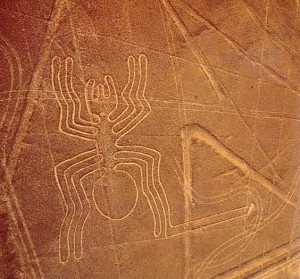
We are told that the astronomer Phyllis Pitluga has identified the geoglyph of a spider as a representation of the constellation we know as Orion and suggests that lines radiating from it “appear to have been set out to track through the ages the changing declinations of the three stars of Orion’s Belt”. Hancock attributes this to a personal communication. Elsewhere, Dr Pitluga is on record as saying that “she doesn’t agree with the notion that these are representations of constellations”. So which version do we believe? Moreover, in his Between the Lines: the Mystery of the Giant Ground Drawings of Ancient Nasca, Peru (University of Texas Press, 2006), Anthony Aveni has pointed out that she selected only three of fifteen lines emanating from the figure without disclosing the selection criteria: this looks a bit like cherry-picking the data.
Hancock also tells us that the spider has been identified as a member of the Order Ricinulei (although he calls it a genus) by the astronomer Gerald Stanley Hawkins (1928-2003), best known as author of Stonehenge Decoded rather than as an arachnologist. Describing it as “one of the rarest spider genera in the world”, supposedly only found in the Amazon rainforest, he then takes a swipe at orthodox opinion by asking “[h]ow did the supposedly primitive Nazcan artists travel so far from their homeland, crossing the formidable barrier of the Andes, to obtain a specimen?”. According to the British Arachnological Society, Ricinulei is rather more widespread than this, being found in humid parts of Africa, the southern United States, Central America and South America. While the Nazca Plain is not a humid place, the Nazca culture developed a system of irrigation using puquios, underground channels with ojos (eyes) as access points: these sound an ideal habitat for Ricinulei, which inhabit caves as well as leaf mould in rainforests. It would be instructive to find out if any have been found in puquios, many of which still hold flowing water.
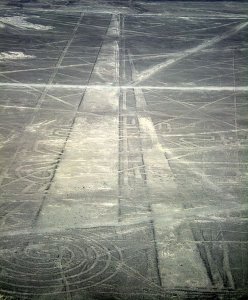
So much for the spider. What about the lines? Hancock marvels at the ability of the Nazca culture to construct lines that run dead straight for more than eight kilometres, “marching like Roman roads across the desert, dropping into dried-out river beds, surmounting rocky outcrops, and never once deviating from true”. He thinks that this precision is hard (but not impossible) to explain and has given the game away in his simile of Roman roads: we know that long-distance alignments were built by Roman engineers using very basic technology that would not have been beyond the capabilities of the Nazca culture.
Graham Hancock closes the chapter much as he opened it, with an eloquent description of flying over the lines. This time, though, he has set the reader up with enough innuendoes about the origins and date of the geoglyphs to be able to treat us to a string of non sequiturs whose sole purpose is to make the lines more mysterious. He quotes Maria Reiche, the foremost expert on the lines as saying that they “give the impression of a cipher-script” and mentions “strange local traditions” that associate them with “the Viracochas”.
Chapter 5: recreating the past from legends

We begin a chapter on the “mysteries” of Perú with a statement that underlies so much of the reasoning of “alternative historians” that it could almost form a creed: “[n]o artefacts or monuments, no cities or temples, have endured in recognizable form for longer than the most resilient religious traditions”. Hancock goes on to cite the Egyptian Pyramid Texts, the Hebrew Bible and the Hindu Vedas as “vehicles of knowledge voyaging through time”. This could almost be a manifesto for writers as diverse as Erich von Däniken, Immanuel Velikovsky or Desmond Leslie, who cite ancient myths and legends as evidence for real events in the past. This is technically called euhemerism, after the philosopher Euhemeros (Εὐήμερος), who lived in the late fourth century BCE and who believed that the Greek gods had been real flesh-and-blood people living in the remote past; the myths surrounding them could be interpreted to reveal the history of these very early times. Needless to say, this flies in the face of the modern understanding of the role of myth.
Graham Hancock intends to use the recorded mythology of the Inka (or Inca) state as a means of reconstructing the early history of Perú and interpreting its archaeological remains. We are introduced to the Viracochas, whom Hancock portrays as the founders of Peruvian civilisation. Wiraqocha (also known as Viracocha, Huiracocha, a more Spanish spelling, or Apu Qun Tiqsi Wiraqutra) is indeed the name of the creator god of the Inka, who is credited with creating the sun, moon and stars as well as humanity, by bringing stones to life. His first creatures were giants who somehow offended him, so he sent a flood to destroy them. For his second attempt, he breathed life into smaller stones, creating humans. Eventually, Viracocha walked away, across the Pacific, leaving his creations behind, although some believed that he would return in times of national crisis, much like King Arthur in Britain. In a different version of the legend, the world has passed through five ages: the first age was one where the gods ruled and there was no death; the second was the age when the giants were created; the third age saw the creation humans; the fourth was a warrior age, the time of the civilisations preceding the Inka Empire; the fifth was the Inka Empire, brought to an end by the campaigns of Francisco Pizzaro (1471-1541).
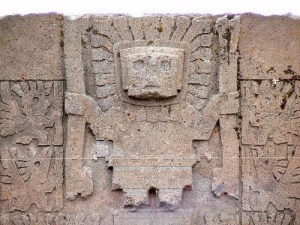
According to Hancock, Wiraqocha means “foam of the sea” and he compares this with the etymology provided by Macrobius for Aphrodite. He does not quote Macrobius directly (the discussion of Aphrodite is in Book III of the Saturnalia), getting the reference second hand from Giorgio de Santillana (1902-1974) and Hertha von Dechend’s (1915-2001) Hamlet’s Mill (Gambit, 1969), a work a pseudoscience claiming to trace all myths back to an original “lost knowledge” that included an understanding of the precession of the equinoxes. Again, we see his reliance on secondary sources rather than doing what any careful scholar would do, which is to return to the original to see if it really says what the secondary source claims it does. Anyway, why rely on Macrobius, a Roman writer of the fifth century CE, when Hesiod’s Theogony (Θεογονία) lines 195-6, written c 700 BCE, provides the earliest authority for Ἀφροδίτην ἀφρογενέα (“foam-born Aphrodite”)? If this is indicative of the depth of research undertaken by Hancock and his team, it should serve as a warning not to trust any of his statements without first checking. It is even unclear why he includes this information, for, as he says, “[n]o doubt it is just a coincidence that the Greek goddess Aphrodite, who was born of the sea, received her name because of ‘the foam [aphros] out of which she was formed’”.
Which brings us on to the etymology of Wiraqocha. Despite Hancock’s certainty that it means “foam of the sea”, for which his authority is The Facts on File Encyclopaedia of World Mythology and Legend (Blandford, 1992), there are other explanations for the name. The Oxford Dictionary of World Mythology, a more academic source than the Facts on File series, suggests that the name means ‘the lake of creation’. Indeed, in Quechua, wira does not mean “foam” but “fat”, “grease” or “wax”: “foam” is phosoqo. Qocha (or qucha) means “lake” or “pond”. This may appear to be petty nit-picking, but it serves to illustrate Graham Hancock’s methods: present data without indicating that there are interpretations other than those he chooses to vouchsafe to the reader. It also shows how he will use one source as an authority without indicating its limitations or its tendentious nature (although, in this instance, it is the use of a popularising rather than an academic text).
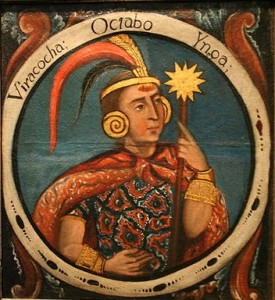
Like many “alternative historians”, Graham Hancock is impressed with the Conquistadores description of Wiraqocha, noting how they described his appearance as similar to depictions of Saint Bartholomew or Saint Thomas. He takes this to mean that Wiraqocha was seen as a bearded “Caucasian”. Some early Spanish chroniclers, including Pedro Cieza de León (c 1520-1554), Pedro Sarmiento de Gamboa (1532-1592) and Juan Diaz de Betanzos (1510-1576), attribute the initial lack of hostility shown to the Conquistadors by the Peruvians to the alleged resemblance of the Spanish to Wiraqocha. However, this is now thought to be Spanish propaganda, as none of the legends mentions his allegedly pale skin and there are South American peoples who do cultivate beards, including the Aché of Paraguay. It is worth noting that the Aztec god Quetzalcoatl was also depicted with a beard, but according to the Anales de Cuauhtitlan, Quetzalcoatl’s beard was actually part of a mask and was made from feathers. This all suggests that it is unwarranted to assume that an historical Wiraqocha was of European origin, as Hancock insinuates.
Chapter 6: Wiraqocha the civiliser
Discussion of Wiraqocha continues into the next chapter, where his role as the bringer of civilisation—arts, technology, farming and so on—is stressed. In this sense, he performed for the Inka the role that was given by the Egyptians to the god Osiris. These are widespread myth types and are perhaps part of an attempt by ancient peoples to explain the origins of their cultures and to show why their cultures differed from those of their neighbours. The euhemerisation of the character is unnecessary, as a character of this sort is clearly a widespread mythological motif.
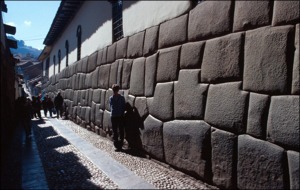
At last, though, we are treated to some archaeological observations. First comes Graham Hancock’s impression that “by no means all the so-called Inca masonry could be attributed with any degree of archaeological certainty to the Incas”. But it is no more than that: an impression. He gives no references to back up the statement. Here we see yet another of his techniques that is so far from the scholarship to which he aims: innuendo. This is nothing more than a rhetorical trick, allowing him to counter critics who might bring forward proof that the masonry is indeed to be attributed to the period of the Inka Empire with a simple “But I never said it wasn’t Inka”.
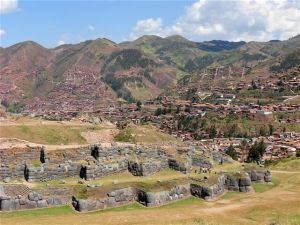
The first Inka site that Hancock mentions by name outside Cuzco is Saksaywaman (often spelled, as Hancock does, in a Spanish form as Sacsayhuaman). Accounts of the conquest of Perú show that it functioned as a citadel protecting the city of Cuzco and that its function during the attempted insurrection of Manco Inka was to act as a fortress. There are descriptions of the complex before it was demolished that show that it held store-rooms in a labyrinthine arrangement, had towers and rooms with large windows overlooking the city. The walls are made from andesite blocks that have been cut into irregular but loosely fitting shapes, a typical Inca technique. This, and the fact that they slope in towards the top have ensured that they are highly resistant to earthquake: the destruction of the site has been deliberate and is not the effect of time. The stone blocks were initially shaped by pounding with river pebbles and dragged to the site by rope (and, to forestall accusations that this is all hypothesis, there is a description of a storeroom for building materials by Diego de Trujillo (1505-1575) that mentions these) and finally dressed on site. Sakaywaman is not a mysterious site by any means.
This does not deter Graham Hancock. He uses the rhetorical question with the aplomb of von Däniken: “How had the Incas, or their predecessors, been able to work stone on such a gargantuan scale? How had they cut and shaped these Cyclopean boulders so precisely? How had they transported them tens of miles from distant quarries? By what means had they made walls of them, shuffling the individual blocks around and raising them high above the ground with such apparent ease?”. Throw in a non sequitur (“These people weren’t even supposed to have had the wheel, let alone machinery capable of lifting and manipulating dozens of irregularly shaped 100-ton blocks”) and the innuendo is complete. Hancock is not going to tell you that the answers are already known.
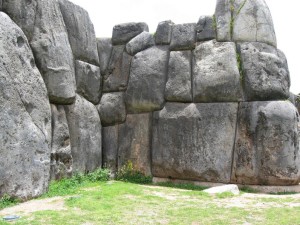
The date of the fortress is also dismissed with a curt “[r]adiocarbon was redundant in such circumstances; thermo-luminescence, too, was useless”. This is irrelevant. Hancock seems not to know or not to care that there are other ways of dating masonry. The walls have foundation trenches, which will cut through earlier deposits, will be backfilled with material that (if one is lucky) contains objects contemporary with the construction and the walls will be butted by deposits that formed after the foundation trenches were backfilled. This is very basic stuff. If Hancock does not know it, then he has no right in producing a book criticising the data obtained by archaeology. If he does, then he is deliberately leading the reader astray. I suspect that I know which is the more likely scenario.
There are historically derived dates for the Inca Empire, which have now been tested against radiocarbon chronologies by Anna Adamska as part of her Master’s thesis for the University of Warsaw. The radiocarbon determinations match the historical dates well and suggest that the pre-Imperial phase of Inka culture lasted some 120 to 150 years from c 1275-1425 CE. What Hancock is not going to tell you is that Saksaywaman overlies an earlier structure, whose pottery places it in the Killke culture and which has produced a radiocarbon date (!) of c 1100 CE. Sakaywaman must therefore be later. Garcilaso de la Vega and Juan de Betanzos both attribute its construction to Inka Yupanki, who flourished around 1450 CE. Although Hancock approvingly quotes Garcilaso de la Vega when he describes how a later Inka had attempted and failed to move blocks on the scale of those used at Saksaywaman, he notably fails to quote him as an authority for the date of the site. This is selective use of historical sources! Never mind, Hancock is going to stick with his manifesto from the start of Chapter 5: cultural myths are “vehicles of knowledge voyaging through time” that apparently trump historical sources and archaeological data.
Chapter 7: Mr Hancock takes the train
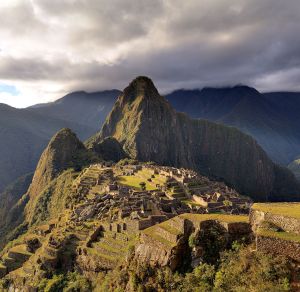
One has the impression that Hancock is rather fond of Wiraqocha. At least, he keeps mentioning him; now we are told about the flood story associated with him and his appearance in the country of Tiwanaku. But this is not where the train is going (the book has an underlying travelogue theme), so Hancock makes “a mental note to find out more about Lake Titicaca, and the mysterious Tiahuanaco”. Instead, he is off to Machu Pikchu, with long enough to muse about the myths “voyaging through time” on an unspecified type of vehicle.
On arrival at the site, Hancock is impressed by the terraces on Wana Pikchu, the sugarloaf peak that overlooks Machu Pikchu and speculates that perhaps “somebody had been up there and had carefully raked the near-vertical cliffs into a graceful hanging garden which had perhaps in ancient times been planted with bright flowers”. Never mind that these terraces are typical Peruvian cultivation terraces—we don’t want to ruin things for the reader by doing anything so mundane as research into the economy of these people, do we?—and that the site is hardly a representative of “ancient times” when it dates from the reigns of Pachakutiq Inka Yupanki (1438-71) and Tupaq Inka Yupanki (1472-93). By that sort of reckoning, the Tower of London would be practically prehistoric.
Hancock does mention the consensus date of construction, only to dismiss it. Instead, he prefers to use archaeoastronomy and the wildly speculative ideas of the astronomer Rolf Müller (1898-1981), who detected alignments in the site that he claimed dated it to 4000-2000 BCE. At last, Hancock is getting near to the sort of antiquity he wants for the type of masonry found on Inka sites. There is a wonderful dismissal of academic historical methodology and praise for archaeoastronomical ideas in a footnote: “Another scholar, Maria Schulten de D’Ebneth, also worked with mathematical methods (as opposed to historical methods which are heavily speculative and interpretive)”. Hancock appears never to have heard of Garbage In, Garbage Out (GiGo)!
And that’s it for this chapter. No attempt to engage with the archaeology of Machu Pikchu at all; the best he can do is mention the Intiwatana (Intihuatana in its Spanish spelling), the complex carved piece of bedrock probably given its name by Hiram Bingham, discoverer of the site, referring to it as “unusual” as if it were the only one of its kind. Never mind the known cultural context, just bamboozle the reader with unfamiliar terms.
Chapter 8: In which Mr and Mrs Hancock take an aeroplane ride to Bolívia
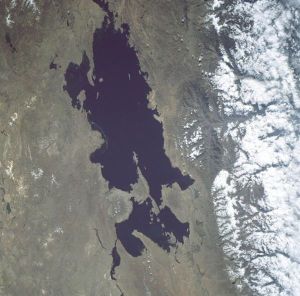
Remembering the mental note he made on the train journey to Machu Pikchu, Graham Hancock now decides to investigate Tiwanaku and Lake Titicaca. The Lake is an unusual place, a lake suspended some 3.8 km above sea level on the Altiplano of the high Andes. Despite Hancock implying that it is saline (he refers to its fauna as “marine”) and was formed by the uplift of the Andes some 100 million years ago trapping a quantity of ocean water, it is a freshwater lake and occupies the bottom of a pull-apart basin that formed during the late Oligocene and Miocene (i.e. around 28.1 to 7.25 million years ago).
What we are reading is a presentation of five bullet points (“mysteries”, Hancock calls them) that contain data designed to make us think that Lake Titicaca has an unknown history. The fossilised sea shells found on the Altiplano are not evidence that this area had a marine ecology during the human past, while the alleged “marine icthyofauna” (here Hancock is quoting Arthur Posnansky (1873-1946), an amateur archaeologist who dated Tiwanaku to c 15,000 BCE: ask yourself why he is not quoting an expert in the ecology of Lake Titicaca) do not appear in available information about the fauna of the lake. These two bullet points are pure innuendo designed to create an impression: their “facts” are either irrelevant to the archaeology of Tiwanaku or are just plain wrong.
Bullet point 3, which Hancock considers mysterious, concerns the evidence for different levels of the lake in the past. There is no mystery: geologists have named and dated these five precursors to Lake Titicaca. Lake Mataro, at an elevation of 3,950 m, appears to be the earliest and perhaps dates from the Late Pliocene (3.6-2.6 million years ago); Lake Cabana, at an elevation of 3,900 m, appears to be Middle Pleistocene in date (1.8 to 0.8 million years ago); Lake Ballivián, at an elevation of 3,860 m, dating from 120,000 to 98,000 BP; Lake Minchin, at an elevation of 3,825 m, dates from 72,000 to 68,000 BP; Lake Tauca, at an elevation 3,815 m, from 18,100 to 14,100 BP. Hancock completely misrepresents these shorelines as evidence that the Andes are still rising and mistakes shorelines from two separate lakes as evidence that the uplift is greater in the north than in the south. For this, he does not quote geologists, but refers instead to Hans Schindler Bellamy’s (1901-1982) Built before the Flood: the Problem of the Tiahuanaco Ruins (Faber & Faber, 1943); Bellamy was a follower of the lunatic ideas of Hanns Hörbiger (1860-1931), for whom the entire universe was made from ice. One suspects that Graham Hancock is not really expecting his readers to follow up on the utterly ridiculous “authorities” for his fatuous assertions.
For point 4, Hancock returns to Arthur Posnansky, whom he cites as providing “irrefutable evidence that the city of Tiahuanaco was once a port, complete with extensive docks, positioned right on the shore of Lake Titicaca”. This is just plain wrong. Tiwanaku did have a port, at Iwawi (or Iwawe), on the current shoreline of Lake Titicaca some 18 km to the west-north-west of the city, with which it was connected by road. This was known in the 1960s, so there is no excuse for Hancock (or his researchers) not to have discovered the fact. Unless, of course, he doesn’t want his readers to know about it, as it would spoil his idea that Tiwanaku was itself a port. Better still, it has been shown that Iwawi was the port by which stones were brought to Tiwanaku for the construction of its monuments. Point 5 merely uses Immanuel Velikovsky’s (1895-1979) completely discredited idea that a relatively recent, catastrophic uplift pushed Tiwanaku above the level of the lake. What Hancock omits from his quote from Earth in Upheaval (Doubleday, 1955) is the contention that the site was pushed the full 3.8 km above sea level after its construction!
Chapter 9: connecting Titicaca with Egypt

We return to some further musings on Wiraqocha, where he is identified with a minor figure known as Tunupa (or Thunupa), the name of a dormant volcano some 379 km to the south-south-east of Tiwanaku. There seems to be some confusion over Tunupa, as there is a Bolivian myth that makes the volcano female; unless Tunupa had serious hormonal problems, it is difficult to see how she might have possessed a beard. At Ollayantambo, there is a “representation” of Wiraqocha or Tunupa in a rock face, where hollows in the rock form the eyes and mouth (it is unclear if they are natural or artificial) and the nose is formed by a partly carved protruding section; ruins above the face may be the remains of a crown. Locals believe the image to be bearded and represent it as such in drawings of the formation.
According to Paul Richard Steele and Catherine J Allen’s Handbook of Inca Mythology (ABE-CLIO, 2004), Tunupa was the principal god of Aymará speakers (who include the people of the Tiwanaku region) who is today thought to be responsible for lightning and is identified with Santiago; on the other hand, the early seventeenth-century writer Juan de Santa Cruz Pachacuti Yamqui Salcamayhua attributed the creative acts of Wiraqocha to him, although he later turned people who had offended him to stone, including the citizens of Tiwanaku. Pachacuti identified him with Saint Thomas. The Augustinian Friar Alonso Ramos Gavilán, a contemporary of Pachacuti, identified Tunupa with one of the disciples, although the influence of his religious beliefs may well have influenced this identification. It is only Pedro Cieza de León (1518-1554) who describes Tunupa as white, an essential part of Hancock’s exposition of the character (and one that appears to be quite a sensitive issue to him); as one of the writers of the conquest period, it is possible that he was influenced by the Spanish propaganda that made Wiraqocha a white man.
Graham Hancock draws a parallel between Tunupa and the Egyptian Osiris, quoting Gavilán’s version of the story, in which he is murdered and placed aboard a raft on Lake Titicaca. Blown by the wind, it was swept into the Rio Desaguadero and, eventually, underground. We are once again given two rhetorical questions, designed to make us suspect that the stories have a common origin: “Are such parallels to be dismissed as coincidences? or could there be some underlying connection?”.

This digression into Egyptian mythology has an underlying purpose. This is to introduce the famous totora reed boats of Lake Titicaca that so impressed Thor Heyerdahl (1914-2002) as being similar to Egyptian papyrus boats that he sailed the Atlantic in a futile attempt to show that Maya culture derived directly from Egypt. His references are all to a single work… yes, Heyerdahl’s The Ra Expeditions (Allen & Unwin, 1970). This is neither good research nor real scholarship. If Hancock wants his ideas taken seriously by academia—and I’m not convinced that he does—then he needs to use the methods of rigorous scholarship that are the norms in academia. Instead, his methods give the impression that he wants to win over (uninformed/poorly-informed) public opinion.
Chapter 10: Tiwanaku explored

To read only Graham Hancock’s account of Tiwanaku, one would think that almost no archaeological research has been carried out at the site, that its conventional dating has been arrived at by little more than guesswork and that there are no solid data by which to uncover the history of the site other than the ramblings of Arthur Posnansky. But we are not going to rely on a single source. Instead, we will find out if there is more to Tiwanaku than is presented in Fingerprints of the Gods.
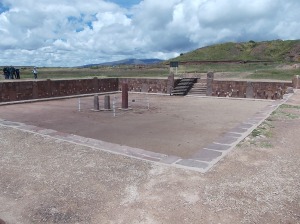
Graham Hancock begins with a good description of what he calls the “sunken temple” (in Spanish and in the academic literature, it is usually referred to as the Templete Semisubterráneo) but fails to recognise that it is a typical feature of earlier highland cultures. Similar and earlier examples are found in the cities of Chavín, Qalayu and Pukará and became a standard element of the cities from Tiwanaku’s expansionist period. As ever, he will not tell his readers that there is a cultural context for phenomena he wants to present as unique and mysterious. The centre of the Templete, the floor of which sits two metres below ground level, was occupied by a group of stelae (now mostly missing, apart from the Pachamama, otherwise known as the Bennett Monolith, a 20 tonne stone standing 7.3 m high), which Pedro Cieza de León thought to have been idols. Hancock does not describe the Pachamama, as it stood in La Paz from 1933 to 2002, a symptom of the looting that Tiwanaku suffered in the centuries after its abandonment. Instead, he describes the sandstone Monolito Barbado or Bearded Monolith, thought to represent Wiraqocha Kon-Tiki, “Lord of the Waters”; although it “dominated it [i.e. the Templete], like the conductor of an orchestra”, Hancock seems unaware that the Pachamama would have dwarfed it. Hancock’s idea that the two other surviving stelae were “possibly intended to represent Viracocha’s legendary companions” fails to take into account the fact that there were originally numerous others, long since taken away.

The walls of the Templete are formed from 57 monolithic pillars of red sandstone, with smaller sandstone blocks filling in between them; some 175 limestone heads, all different, are arranged around the walls. Hancock considers these heads the “most striking feature” of the Templete and says that “[t]here were several different (and contradictory) scholarly opinions as to their function”, although he does not reveal what these “scholarly opinions” might be. One plausible suggestion is that the heads represent different ethnic or tribal groups subsumed into the Tiwanaku Empire. These sunken courts were an important element in civic ritual in the culture of Tiwanaku and, here in the heart of the Empire, the portrayal of idealised ethnic types may have been an attempt to draw all together in a symbolic representation of that Empire.
Hancock then turns his attention to the Akapana, a pyramid of South American type, consisting of seven stepped terraces on a base with a complex ground plan, measuring 257 by 197 m and rising to a height of 18 metres. Each walled step shows a different construction technique, the lowest having rusticated stonework and the upper six with ashlar masonry; each wall is a skin containing compacted soil. There is a staircase on the western side, leading to the top of the pyramid; on the uppermost terrace is a cross-shaped sunken courtyard. Originally, the staircase was lined with reliefs depicting the Chachapuma (Man/Puma), which have been removed and can now be seen in the Museo regional de Arqueología de Tiwanaku. The sides of the pyramid are aligned on the cardinal points and it has been suggested that the pyramid was dedicated to solar worship. Hancock is impressed by the alignment on the cardinal points and is reminded of the “pyramids at Giza in Egypt”, although this is about the only feature they share.

Climbing to the top, Graham Hancock “realized that the true function of the pyramid was probably never going to be understood”, showing a tremendous pessimism that is not shared by most archaeologists. While we can never recover all the subtleties of a prehistoric culture, with its complex belief systems, legal codes, social relations and so on that are lost to history, we can nevertheless formulate hypotheses about the past and test them against the data. After all, isn’t this what Hancock is claiming to do? A great deal more is known about the Akapana since excavation began under Carlos Ponce Sanginés (1925-2005) than Hancock tells us. Paul Goldstein, for instance, has argued that the Akapana pyramid is the most important feature of the city, with its image recurring in reliefs across the site, as first noted by Posnansky. E Fred Legner has suggested that the Tiwanaku culture had a three-tiered cosmology, with the Templete representing the underworld of fertility gods and the ancestors (Ucu Pacha), while the Akapana and Puma Punku represent the Hanan Pacha (upper world) where the celestial gods reside; humans occupy the central world (Cay Pacha).
Hancock is amazed by the drains of the Akapana. They consist of sandstone channels held together with I-shaped copper clamps, which he compares with cramps used in Egypt, contending that they are “not known to have been employed anywhere else in South America”. Whether they were or not is a question I will leave to those better informed about the archaeology of the continent, although they were certainly used at Ollantaytambo (Perú), some 531 km north-west of Tiwanaku. Metal clamps (although possibly of gold) also seem to have been used in Inka architecture. However, the mention of Egypt is utterly gratuitous and tendentious: Hancock has been at pains to point out supposed resemblances between South American and Egyptian culture (Wiraqocha/Osiris, totora reed boats on Titicaca/papyrus boats on the Nile and the alignment of the Akapana/the alignment of the Giza pyramids) that have no basis in what we know of the archaeology of the two places. His impression that the Akapana is somehow “some kind of arcane ‘device’ or machine” is no more than that: it is an elaborately constructed pyramid, typical of the region, with drains presumably to remove liquids. We are experiencing another of those innuendoes that pepper the book. Without actually claiming anything positive, Hancock is insinuating in our minds that the Akapana is somehow connected with a high technology.

Next, he moves on to the Kalasasaya and, in particular, the Puerta del Sol (“Gate of the Sun”). The name Kalasasaya seems to mean “standing stone(s)” (kala means “rock” or “stone”, while saya or sayasta means “standing”) and consists of a platform around 130 by 120 m and around 2 m high. Like the Akapana, it is aligned on the cardinal points, with its long axis pointing west to east; it is entered by steps on the eastern side. Along the northern and southern walls are seven small semi-subterranean rooms. The Puerta del Sol, which was ruinous at the start of the twentieth century, has been reconstructed but is not in its original location; it was clearly once part of a larger structure. He cites Hans Schindler Bellamy and Peter Allan’s The Calendar of Tiahuanaco: the Measuring System of the Oldest Civilization (Faber & Faber, 1956) as an authority for the calendrical nature of the Puerta and suddenly, the chapter ends.
Chapter 11: fish, elephants and Toxodon
The start of this chapter is taken up with a good description of the astronomical phenomenon of the obliquity of the ecliptic. He needs to do this to set the reader up for Arthur Posnansky’s date of 15,000 BCE for the Kalasasaya, which he derived from astronomical alignments. Posnansky’s alignments did not match those of today, so he sought out a date at which they would make sense. Currently, it is around 23.4°, while Posnansky’s calculations require an obliquity of 23.15°. Checking the tables available to him, he discovered that the last time the axial tilt corresponded to this angle was around 15,000 BCE.
Hancock repeats his dismissal of orthodox archaeological opinion, stating that “not a single orthodox historian or archaeologist was prepared to accept such an early origin for Tiahuanaco preferring, as noted in Chapter Eight, to agree on the safe estimate of AD 500”. As I have already noted, this is not a “safe estimate” but a rigorously determined date based on radiocarbon determinations of the stratigraphy of the site. Posnansky’s calculations, on the other hand, depend on establishing alignments between elements of a structure that was ruinous even before he started to survey it. The “high-powered team” of scientists that Posnansky co-opted to check his calculations (Hans Ludendorff (1873-1941), director of the Astronomical Observatory of Potsdam), Friedrich Becker (1900-1981) of the Vatican Observatory, Arnold Kohlschutter (1883-1969) of the University of Bonn and Rolf Müller, whom we have already met) may indeed have verified them, but Hancock remains painfully unaware of the Garbage in, Garbage out maxim.

We then get descriptions of two of the carved monoliths inside the Kalasasaya. The first, known as El Fraile (“The Friar”), was discovered in 1932 and erected in the south-west corner of the enclosure. It stands some 3 m high, slightly taller than Hancock’s estimate. According to Hancock, his lower garment is made from fish scales, represented by stylised fish heads. I confess that I cannot see these. Instead, there appear to be two alternating symbols, one consisting of a sub-square outline with nothing in the centre, the other, an inverted Y with a cross-bar at the top. The second, I suppose, could be a fish face, but this requires some imagination to see. Similarly, the supposed crustaceans on the belt look to me to be stylised human heads. Perhaps someone with a greater understanding of Tiwanaku art can help me out here…
Nevertheless, Hancock needs these fishy details, which had been “persuasively interpreted by Posnansky as meaning fish in general”, to make the connection with the Mesopotamian Adapa (better known as the Greek Oannes (Ὡάννης), also found as Հովհաննես (Hovhannes) in Armenian). Representations of Adapa in the guise of the Babylonian Uanna or Uan (from which the Greek and Armenian forms derive) show him as a man wearing a fish; this is supported by the story of the Seven Sages (Apkallu), of whom Adapa was the first, as being semi-aquatic demigods who were sent from Dilmun by Enki to teach human beings how to live. We are clearly supposed to remember Wiraqocha in this connection.
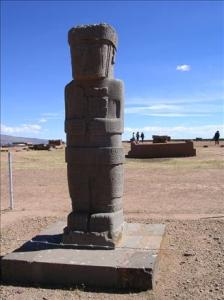
Next, we are given a brief description of the other monolithic statue, this time that known as the Ponce Monolith, after its discoverer, Carlos Ponce Sanginés, who found it in 1957. It is thus not in its original position, like so much else in the mostly reconstructed Kalasasaya. It, too, stands 3 m tall but was carved from andesite. On the basis of excavations in recent years at Pumu Punku, a kilometre to the south-west of the main complex at Tiwanaku, it has been suggested that stonework in andesite pre-dates stonework in sandstone; it is unclear is this distinction can be extended to statuary. The entire statue is covered in symbols and again, although Hancock claims that its lower garment is made from fish scales, they appear to be the same as those on El Fraile.

Finally, we get to the Puerta del Sol, a monolithic doorway around 3 m high and 4 m wide, around 10 tonnes in weight. Hancock seems to be unaware that it is not in its original position, as was Posnansky. He also wants to think of it “as a sort of Arc de Triomphe, though on a much smaller scale”, although it was clearly one part of a larger structure, as shown by the mortise holes on its front and side elevations. It has been speculated that it originally formed part of Puma Punku. It is the frieze that holds Hancock’s attention, with its central character, a representation of Wiraqocha in the form of a god of thunder (he holds a thunderbolt in each hand), weeping for humanity. Either side of Wiraqocha are three rows of eight characters, making 48 in all, consisting of 32 effigies human faces on the top and bottom rows and 16 with a condor’s head on the middle row; all face Wiraqocha.
Why anyone should think this calendrical is beyond me. For a calendar, one needs different symbols for each period being measured. There are only two symbols here, unless one creates a calendar that has periods named “third condor-headed figure on the left of Wiraqocha”, “fourth person, top row, to the right of Wiraqocha”. A more unlikely representation of a calendar is difficult to imagine. Once again, as with the insinuation of a technological purpose for the Akapana, we have talk of “something coldly mathematical, almost machinelike” about the Puerta del Sol. Perhaps it is to someone unfamiliar with the canons of Tiwanaku art…
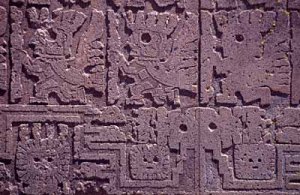
On which subject, we have one of Hancock’s favourite rhetorical tricks. Turning to the bottom register of the frieze on the Puerta, he describes how he can discern “a clear carving of an elephant’s head, ears, tusks and trunk”, even though elephants have been extinct in South America for around 12,000 years. On closer inspection, they turned out to be “composed of the heads of two crested condors, placed throat to throat (the crests constituting the ‘ears’ and the upper part of the necks the ‘tusks’)”. This, of course, is how they are seen by conventional archaeologists. However, because Hancock wants them to be elephants (remember that, in his opinion, Tiwanaku dates from a time five thousand years before their extinction), he says that they are indeed meant to depict elephants because “a characteristic visual trick the sculptors of Tiahuanaco had employed again and again in their subtle and otherworldly art had been to use one thing to depict another”. Nevertheless, they resemble elephants only as child-like cartoonish figures: without having the thought “elephant” planted in the mind first, one simply wouldn’t see them. This is probably an indication that they aren’t there at all.
Better than the elusive condor/elephants, Hancock claims that another creature depicted in this bottom register “had been convincingly identified by several observers as Toxodon”, an extinct creature that he says was semi-aquatic. Although this was formerly believed to be the case, current opinion is that its skeletal structure and distribution in arid areas preclude it. Of course, the “several observers” are characters we have met before—Arthur Posnansky, Hans Schindler Bellamy and Peter Allan—whose qualifications to identify extinct species in pre-Columbian South American art are not well established. The relief and the figurine he shows that are claimed to be Toxodon bear little relationship to the reconstruction drawing he also reproduces of the beast.
Identifying two other extinct species—Shelidoterium and Macrauchenia—he concludes that Tiwanaku “was a kind of picture-book from the past, a record of bizarre animals, now deader than the dodo, expressed in everlasting stone”. Those clever Tiwanakis were evidently able to predict which creatures out of all those that inhabit the Altiplano were destined to become extinct after they had abandoned their unfinished site.
Chapter 12: Puma Punka and Aymará
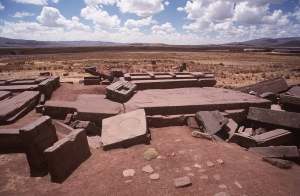
We are coming to the end of Mr and Mrs Hancock’s South American Odyssey. It feels as if it has been a long (and slightly repetitive) journey, but we’re not quite done. We can’t ignore Puma Punku (“Puma Gate”), another platform that lies around a kilometre to the south-west of the main complex at Tiwanaku. He quotes Posnansky’s ridiculous interpretation of the site as “two artificially dredged docks on either side of: ‘a true and magnificent pier or wharf … where hundreds of ships could at the same time take on and unload their heavy burdens’”. We have already seen that the port of Tiwanaku lay 18 km to the west-north-west, at Iwawi, and that the level of the lake was not this high at any time when Tiwanaku was occupied. Puma Punku is instead a terraced mound resembling a low pyramid with only three steps. A radiocarbon date from the soil fill of the lowest terrace of the structure is 1500 ± 25 bp, which calibrates to 569 ± 21 CE (527-611 CE at 2σ, meaning that there is a 98% chance that the sample falls in that date range), gives us a terminus post quem. This is an important archaeological principle by which a deposit cannot be older than the date of the youngest object in it: in other words, there is a 98% probability that Puma Punku dates from after 527 CE. Other evidence—such as the radiocarbon chronology of Iwawi—shows that the level of Lake Titicaca at this time was much the same as it is today. So Puma Punku is not a port structure.
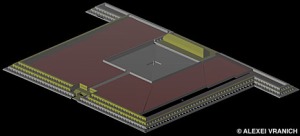
The structure lies in ruins that Posnansky thought had been caused by cataclysmic flooding from Lake Titicaca. This is to ignore the effects of humans, particularly after the Spanish conquest of the Inka Empire, when we know that the site was raided for building stone. We do not know why the site was abandoned, but it was left in an apparently unfinished state. Its massive building blocks, weighing up to 131 tonnes, came from a quarry close to the shore of Lake Titicaca, 10 km away, yet more evidence that the water level was close to that of today.
Hancock then summarises the sophistication of Tiwanaku’s agricultural regime. This is a reasonable, if limited summary of what was known in the early 1990s, although, of course, ongoing research has added more detail. Nevertheless, there are implications that its sophistication is somehow inexplicable, not the result of millennia of experimentation; instead, Hancock suggests that “somebody as yet unidentified by scholarship” brought about an agrarian revolution. This shows an adherence to the Wiraqocha-as-civilisation-bringer type hypothesis for innovation (if we can call it that) rather than the sort of explanation generally preferred by prehistorians: human beings are endlessly inventive and will constantly seek out solutions for the challenges they face.
Next we get an utterly bizarre assertion based on an idea of Ivan Guzman de Rojas (born 1934), a Bolivian research scientist: “that Aymara might be not only very ancient but, significantly, that it might be a ‘made-up’ language”. By contrast, the linguist Martha James Hardman de Bautista has seen affinities with the Jaqaru and Kawki languages, proposing that they should be classified in a new language family that she calls Jaqi (although others have proposed the terms Aru or Aymarán). There really is no mystery here: it is a human language like any other.
Conclusions
This has been a long post, because there is a lot to summarise. The next one in the series will also be long, so don’t expect it any time soon!
However, it has been worthwhile in introducing us to some of Hancock’s techniques. While his descriptive prose is good, it is marred by his obvious dislike of academics, particularly archaeologists. He can be snide in his dismissals of our work, especially when it does not agree with his conclusions. He is prone to the logical fallacy of the straw man, putting into the mouths of archaeologists ridiculous ideas that they have never held so that he can demolish them with ease. Instead, he enjoys citing as authorities people who are writing outside their areas of expertise and will quote secondary sources without checking that the original source said what the later source claims it did. There is a tendency to present only one interpretation of the data as irrefutable while dismissing out of hand the opinions of experts without showing why he considers them wrong; he also has a tendency to rely on only one source of information on a particular subject. He is all too willing to give the impression that a site is mysterious when it has been the subject of intensive research over many years and will claim that answers that have already been found do not exist. His use of quotations is also interesting, in that he will cite sentences from a source that backs up his claims, stopping short where they begin to suggest a different interpretation.
Too often, the writing is impressionistic, giving no data or references to back up his assertions, or he proceeds through a string of non-sequiturs. In this way, he is a master of innuendo, which in his hands becomes a rhetorical trick, allowing him to counter potential critics with a simple “But I never said that” (as he has indeed done since the publication of Fingerprints of the Gods).
His attitude to myths and legends is one that is common to many Bad Archaeologists and it is worth quoting him again on this: “[n]o artefacts or monuments, no cities or temples, have endured in recognizable form for longer than the most resilient religious traditions”. In other words, we can raid religious traditions to provide evidence for real events in the past, a technique known as euhemerism. He prefers to use archaeoastronomy as a tool for dating sites in the mistaken belief that its mathematical basis makes it somehow more rigorous than archaeology, being apparently unaware of Garbage In, Garbage Out.

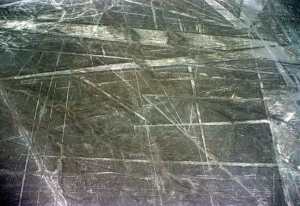
It has been somewhat interesting to me ,but my discovery has led me to believe that nothing in our current history tells us anything new . and there is a complete new case for an ancient civilization existing and the ONLY! way to authenticate it is visit and view for yourself …i believe too much of my important research has been taken up by trying to defend my discovery to ignorant and sceptical individuals ,mainly academics .100 % of people who have viewed my sites and carved stone artifacts agree that what i have discovered and where {in situ .} relates to a very old culture possibly pre. Adamic .. …what this space !! it will prove itself right … Badger Bloomfield ..10 Hunter Str. Dannevirke .Tararua .New Zealand … ph. 06 374 7744 .
LikeLike
You might be slightly mislead about what ‘history’ is if you expect it to produce something ‘new’. All the events of history have already happened, and eventually we will know all there is to know about them, if we do not already.
LikeLike
Thanks again for your reasoned outlook. I also appreciate being able to direct my students to your site for more information.
LikeLike
Regarding Phyllis Pitluga, you gave the following quote: “she doesn’t agree with the notion that these [Nazca lines] are representations of constellations”. From the source you cited, this statement was nestled in a slightly bigger blurb:
“On the basis of her studies, Phillis [Pitluga] came to the conclusion that these are representations of heavenly bodies. But, she doesn’t agree with the notion that these are representations of constellations. According to Phillis, these are counter constellations which account for the irregular dark areas in the Milky Way.”
The way you quoted the source kind of made it seem as though you were saying that Pitluga was responding to Graham Hancock directly in disowning the idea that the Nazca lines represent constellations.
Actually, according to your source, it seems that the German archeologist Maria Reiche recruited the astronomer Pitluga to investigate the site and to examine Reiche’s hypothesis that the lines represent constellations, especially after it was discovered that some of the lines represent summer and winter solstices. And your source, as I’ve quoted above, indicated that Pitluga did not agree with Reiche but rather hypothesized that the Nazca lines/images represented “counter constellations.”
I’m not an astronomer. I’m not an archeologist. I haven’t read Fingerprints of the Gods, but I’ve seen Quest for the Lost Civilization and several Graham Hancock interviews, all in the last week when I stumbled upon this stuff, which is quite entertaining — both the alleged pseudo archeological theories and the debates generated. I am keenly interested in the dialogue between the “real” archeologists and the “pseudo” archeologists because I’ve encountered a similar dialogue in my own profession.
Keith, you have put forth a lot of effort in debunking Hancock’s work so far, and I’m sure there is more to come. Given your apparently successful career as an archeologist and your passion for your work . . . why do you care if someone like Graham Hancock is putting forth unconventional theories that have popular appeal? Why has this grabbed you so much?
The small part of your writing that I’ve focused on regarding the Nazca lines makes me wonder about your own approach in presenting data. Would you agree that the way you presented your Pitluga quotations was somewhat misleading?
LikeLike
Well, no, I don’t even suggest that Phyllis Pitluga has responded to Hancock; re-reading what I wrote doesn’t imply that at all. It’s not misleading in the slightest to show that her ideas about the Nazca lines are not quite what Hancock presents them as being. It’s a characteristic of his approach that he avoids any hint that his sources may offer more nuanced interpretations than those he chooses to quote.
As you are concerned “about [my] own approach in presenting data”, I’d ask you to read the remainder of my Hancock posts and ask yourself if my approach is data led or personality led. And if you wonder why I “care if someone like Graham Hancock is putting forth unconventional theories that have popular appeal”, I’d ask you to read bpoth my introduction to why I decided to deal with Fingerprints of the Gods and the introduction to the main website. Both should leave you in no doubt about why I consider this important.
LikeLike
That’s true that you don’t suggest that Pitluga was responding to Hancock, in the sense that you don’t say, “Pitluga’s response to Hancock was that the spider is not a representation of Orion.” What I’m pointing out is that the way you wrote the paragraph isn’t a clear presentation of Pitluga’s stance, according to the source you used. You didn’t include other information that the source stated, such as that Pitluga did think that the Nazca lines were representations of heavenly bodies and that, although she disagreed with Reiche that the spider mirrored Orion, she did believe that it represented a counter constellation. Presenting those points casts a different light on the conversation as it pertains to what Hancock believes.
And you didn’t say that she wasn’t responding to Hancock. And even though when you read what you wrote, there doesn’t seem to be any doubt about what you meant — to you — you might consider that others might read it differently.
I was not suggesting that you were misleading your readers by trying to point out that Hancock misrepresents Pitluga’s opinions. I was pointing out that you did not accurately or completely represent Pitluga’s opinions yourself. To me, that’s misleading. And basically makes you guilty of the same brand of misrepresentation that you attribute to Hancock. You chose to quote one sentence from your source and left out crucial data.
Data led vs personality led: the latter. I’ve submitted a comment on your original blog outlining my opinions about this. In short, your personal mission to battle the world’s ignorance about “real” archeology is littered with irritation, frustration, and a dismissive attitude towards people that you find stupid. And so far, your efforts to debunk Graham Hancock have the same flavor.
I know you consider it important to put an end to Graham Hancock and pseudo archeology. And stupidity. But knowing that you think it’s important still doesn’t answer the question of why Fingerprints of the Gods has a firm grip on you. I’m glad it does, because despite your attitude problem, you offer other data and perspectives on the issues. So far, nothing I’ve read of your rebuttal to Hancock’s book feels like a slam dunk in the sense that you make it clear that his opinion is irrefutably false because of data you present. But you introduce other information into the conversation, and I consider that information a good starting point for further inquiry and reading (as opposed to definitive proof of anything). Kind of like Hancock’s book, which I’ve started to read. In fact, I feel like your project and Hancock’s work have many things in common. And my guess is that he welcomes your project because it perpetuates the conversation he started with his book.
LikeLike
Do you think that ancient people were ‘primitive tribesmen’ or are you engaging with the hypotheses that they were not?
In the chapter 5 section are you claiming that Hancock insinuating or that he is assuming that an historical Wiraqocha was of European origin and why is it warranted to believe that his hypotheses is wrong?
In the chapter 6 section you give no evidence to support your claims that Hancock has been ‘unscholarly’ and what exactly does a room full of ropes and stones prove about building techniques from hundreds or thousands of years earlier?
‘Saksaywaman overlies an earlier structure’ you appear to have left out any evidence to support this this claim.
Could you please provide some actual evidence of how Hancock is attempting to trump historical sources and archaeological data? He seems to me to be referencing historical sources and archaeological data.
‘..stones were brought to Tiwanaku’ : ‘..we easily imagined past people coming here to select natural stones [but not the green andesite of Tiwanaku], then bringing them down to Kanamarka to be bounce-worked into shape, before loading them onto reed boats’ is this seriously your idea of evidence?
You drop some consensus dates for the Incas but how were these established and what exactly do they prove about anything relevant to Hancock’s hypotheses?
Is the female Tunupa in the Oxford Dictionary of World Mythology or does she just appear on boliviabella.com?
By the way its great to see that ‘real scholars’, if that is what you claim to be, do have the skills to reference the Oxford Dictionary of World Mythology.
What is the significance of what E Fred Legner has suggested or is that something that something for the ‘academics’ to think about?
You claim there is a 98% chance that the soil sample from Puma Punku dates from after 527 CE, the facts are important, and implying that the stonework therefore must be dated to 527 CE or later is misleading.
Your conclusions do not appear to be supported by any actual evidence.
If I have been mislead by Graham Hancock I would like to know the the facts so could you please provide some actual evidence to support your claims? With only opinions and hearsay and no evidence your post is no more than misleading hypocritical garbage.
LikeLike
“depict them as primitive tribesmen who unaccountably developed sophisticated techniques of artistic self-expression, and then vanished from the Peruvian scene”
The irony (or is it hypocrisy?) here is that Hancock and his ilk are the ones who believe it’s more likely that an impossible ancient (white) civilization is responsible for the artifacts of indigenous American cultures and for teaching them civilisation than that they were developed by those cultures themselves.
The worst about “scholars” like Hancock is the racism contained in their pop-BS theories, redirecting the origins of civilisation from non-white peoples (I know Semitic peoples are Caucasian, but they are often conceived as non-white, and the insistence upon the blueness of Hancock’s Wiraqocha’s eyes suggests that to be the case) towards the lily-fair. In another time and place, Hancock would refer to this ancient civilisation as “Aryans” or “Hyperboreans”
LikeLike
https://polldaddy.com/js/rating/rating.jsYou must be from South-Africa to make everything a “race” issue! My ancestors were black skinned, or just simply “black people” and I do not find anything wrong, or racist about this. Remember, there is only one race, the human race!
LikeLike
I think that the work Hancock and others are doing is extremely important and ultimately good for our view of history and our understanding of archeology. Archeology tends to be very dry and it’s teachers some what on the bland side. Hancock opens up the field inviting lively debate. It is true that some of his earlier work that you are referencing was a bit sloppy and perhaps a bit to judgmental. However it is clear to me that you are not following his work currently has his network and resources have grown ( it seems to me) exponentially and his research has been refined. I am finding more that ‘mainstream’ archeology is in fact coming more to his side in his general theory that there is a missing chapter in human history and that civilization arose much earlier and to higher level of sophistication than has previously been acknowledged. Archeologist are to quick to assume because they can only think of banging two rocks together that is clearly how ancient peoples did it. Archeology is not a science, but must rely on science to help form conclusions. And as a practice that relies on investigation people like Hancock must be included in the fold has he has clearly done a tremendous amount of research and his conclusions are,bearing real and tangible results that are being incorporated in archeology regardless of how you feel about his methods.
LikeLike
No, Hancock and others’ work is not “extremely important and ultimately good for our view of history and our understanding of archeology”: quite the reverse. It undermines the public’s already limited understanding of the past by providing easy answers (“I don’t know how people without twenty-first century technology could do this, therefore it must have been a “lost civilisation”/aliens” etc.).
Archaeology is a science in the same way as sociology and anthropology are sciences: we rely on the collection of data and build models that attempt to explain those data. Hancock does not understand archaeological methodology and doesn’t want to: his contempt for archaeologists is obvious and this makes it all too clear that he has no intention of ever understanding how we work. He is a writer in the dishonourable but currently popular tradition of expert bashing.
LikeLike
Keith !the day you arrive at my doorstep to examine the stone carvings I have a discovered will be the day you will understand historically what our ancient culture had achieved in the Pleistocene Period ..this time line has been verified by senior scientist with G.N.S-N.Z. Dr. Hamish Campbell and members of the Pleistocene Coalition …Unknown science is awaiting us and pushing us towards understanding ancient history.I am willing to explain my methodology of restoration to anyone who wishs to learn .called “The Badger Effect”.I have so much new data here that nobody wishes to read, scepticism and ignorance seem to be alive and well in the fields of Academia -Archaeology -Anthropology,,,,,,Geology seems to be setting the pace …thank God for that …Badger Bloomfield .Independent Archaeologist …
LikeLike
Unless your a Native American, it is NOT your ancient history! If you want to find YOUR history, travel to Europe and become an Archeaologist!
LikeLike
After reading your articles, I went back to re-read FOTG. I must say, I still really subscribe to a lot of Hancocks theory and reasoning- Particularly regarding Egypt
But I wanted to leave a comment thanking you for your writeups, they are a well thought out and informed response in this dialogue
LikeLike
It really just sounds like you’re upset Hancock makes more money than you.
LikeLike
It angers me that Hancock not only makes a lot more money than I could ever hope to, but also that he does it by duping the public. There is no way that he is ignorant of the data that ruin his hypothesis, which he does not share; he is on record as saying that he deliberately suppresses anything that does not confirm his ideas.
LikeLiked by 1 person
Well at some point, someone should’ve told you you can make more money with honey… or something like that. You seem like someone on a holy crusade to purge all unworthy thoughts from the minds of the people… and I’m quite sure people today enjoy that as much as historical people did.
LikeLike
Thanks for this post. I read FOTGs as a teenager and it actually was extremely formative in my worldview. I was always susceptible to conspiracy thinking, but it certainly helped me along the way too. I have since become more aware of Hancock’s sloppy scholarship (he even self-describes some of his mistakes this way) and have matured enough to see how speculative all of his theories are.
Keith, do you have a link to where Hancock says he suppresses things that go against his theories? I’d love to see that.
Thanks again.
LikeLike
Don’t let it make you angry, it’s not really that important. Save your anger for something worthwhile. Nothing wrong with imagining different narratives for what happened in the past. Many cultures have their own versions of what happened before the current time which are very different from the ‘factual’ events that can be deduced via scientific enquiry. It’s part of being human. The struggle for supremacy of Mythic time vs factual/historic time is a modern western concern, as is the obsession with scepticism and debunking. People buy Hancock’s books because they like to wonder about his fantastic claims, the same way you might enjoy a good yarn. If he’s making a good living out if it then good on him.
LikeLike
Keith, Thank you so much for you lucid and rigorous analysis of Hancock’s dubious work. Hancock blatantly break every rule of logical thinking and data based research. It is sad to read some of these comments and see, even after reading your excellent expose of Hancock’s flaws, people cling to slick deceptions rather than legitimate research. They are clearly emotionally invested in these fantastical theories and the misplaced pleasures of “expert bashing”, both of which have taken very deep and dangerous roots in our rabidly anti-intellectual popular culture. As a teacher of college level history, this is why I think it is important to take on these pseudo-scholars: I teach history because I believe understanding the past is essential to understanding the world we live in today. If people believe in falsehoods as history, they have a distorted view of our world and how it works. In fact, this “magical thinking” has seeped into our political views, voting choices and other areas that impact our day to day lives. Every totalitarian movement has based their appeal on a false historical narrative and conspiracy theories. You are doing important work.
LikeLike
Thank you, Keith, for going so far beyond the call of duty to present the factual basis for dismissing the “bad archeologists.” I disagree with the claims of a previous commenter on this post that you are personality driven here. And I also disagree that you have not presented a slam-dunk case against the claims of Hancock. Based on the facts you present, I do now consider these claims (and the countless internet and email claims I’ve encountered regarding those ancient maps) to be irrefutably disproven. I did have, before this, some respect for Hancock as a seemingly honest intellectual, despite having qualms with his promotion of Ayahuasca as some kind of magical cure-all in his “censored” TED talk. (I know someone who, by all accounts of friends and family, is being psychologically damaged by literally religious devotion to taking Ayahuasca one or more times per month.)
But “seemingly honest intellectual” does not necessarily mean honest. Hancock must now be aware, even if he wasn’t when he wrote his books, that one map he depends on has place names that limit the southernmost portion to Argentina, not Antarctica, and that another of those maps actually has “conjectured” written across the Antarctica section. An intellectually honest researcher would have checked those things before publishing in the first place. An honest person would now be publicly apologizing for his misleading assertions based on those maps. But no, he makes a lot of money duping the public as you say. What has been most depressing reading these sections of your site is how many commenters, even with the facts right in front of them, still give Hancock and his theories unwarranted credence. I think his writing makes for good *fiction* (scifi or fantasy), but as purported history and archeology, it should be condemned.
I most appreciate that you took the time to learn what he said and patiently debunk it with facts. Too much out there is just dismissal (such as “Those people are not credible or qualified” or “that is conspiracy theory,” etc.) instead of explaining so that those without professional experience in the field can understand. Thank you again. I’m sorry you got bored of the topic (though if you kept having to deal with accusations like those above, I understand). I hope some day you write more — and further, publish a book to present it as it deserves. I believed in Atlantis for over a decade. To be fair, most of that time was before the internet took away my excuse for not researching the facts better. Many of my friends still believe in it so strongly that when I express skepticism, I meet outrage and outright suppression of my views. People like me need more facts to hold our own against such fanatical, unexamined belief. Thanks again.
LikeLike
I don’t know about all this. What I do know is when I see someone debunking, I see them overdoing it almost always. First of all, the recollections of an old man are first person account. And I’m sure that’s a valid historical tool. If it wasn’t, then, I think we’d better start looking for evidence of the many things that were told to us by Concentration camp survivors (of all kinds) because their accounts are now invalid also.
I also see a red flag when you say that the Internet is not a reliable source of information about controversial archaeological topics. Actually it’s the best and often the only source for alternative viewpoints of the same finds. The narrative we’ve been told about the past is obviously flawed, so maybe we should just let all the theories prosper in a possibility stew for a hundred years or so, until we have enough information to make a better decision. Trying to shut people up seems like rushing to judgement.
I’d rather hear all the crazy ideas and consider them in a crowdsourcing way. Experts obviously failed us if they omitted/hid information. How many people have heard of these mysteries before the Internet? How many would’ve died and never heard of it, or even had a chance to think about it? How can anyone think that it’s best if people don’t use the internet to research something they enjoy? How can anyone think it’s best if people remain limited by paper-published information on these places and mysteries? How many laypeople even have access to places where paper records exist?
The Internet is a self-entertaining device, not an academic institution. Why would anyone care what John Q Public thinks about some bowl that an old man talks about? How does that change anything at all in the world? I think this debunking of, and outright attempt to thought-control, alternate viewpoints is a result of the discomfort that academics feel whenever the laypeople dare to speak, or whenever their fellow academics dare to speak to the laypeople. Well that boat has sailed. Unless you’d like to support censorship of the Internet?
LikeLike
https://polldaddy.com/js/rating/rating.jsHello,
I am reading this in 2017, and it’s really interesting, thanks for taking the time.
I should say I’m an easy audience for Graham’s work, really wanting to believe in mysterious ancient civilisations.
Graham does have a real story-teller gift, and it’s obvious he did travel a lot to all these places (in starck contrast with Antlantis nuts who will elaborate theories based on Google map). He does present an interesting array of clues, and although some of his hypothesis are probably far fetched, I’m glad his work is at least creating a debate and further research.
LikeLike
You settle too readily on conclusions based on substandard evidence. For example, that it was the opinion of a spanish chronicler that the Incan megaliths were constructed in such-and-such a way, therefore it must be true. That is merely regurgitating third party hearsay, that is not proof. You also, make the quite frankly lazy assumption that just because certain kinds of tool were found lying around on the site, that those must have been the tools used for the original construction. This too, is circumstantial evidence at best and is made unlikely given the scale and precision of the construction found at these sites. The fact is there is a great deal unknown regarding the construction and dating of these sites, and Hancock’s efforts should be praised not blithely belittled.
LikeLike
I don’t call eye-witness observers of the construction of Sacsayhuaman ’substandard’ evidence. Hancock, by contrast, makes up just-so stories and argues from a position of incredulity.
LikeLike